The chemical analysis of a bar of gold metal weighing nearly 2 kg, discovered in 1981 at the bottom of an old canal in Mexico City, made it possible to authenticate this vestige as coming from the treasure looted by Hernan Cortés in 1520 on the Tenochtitlan site. An exceptional discovery.
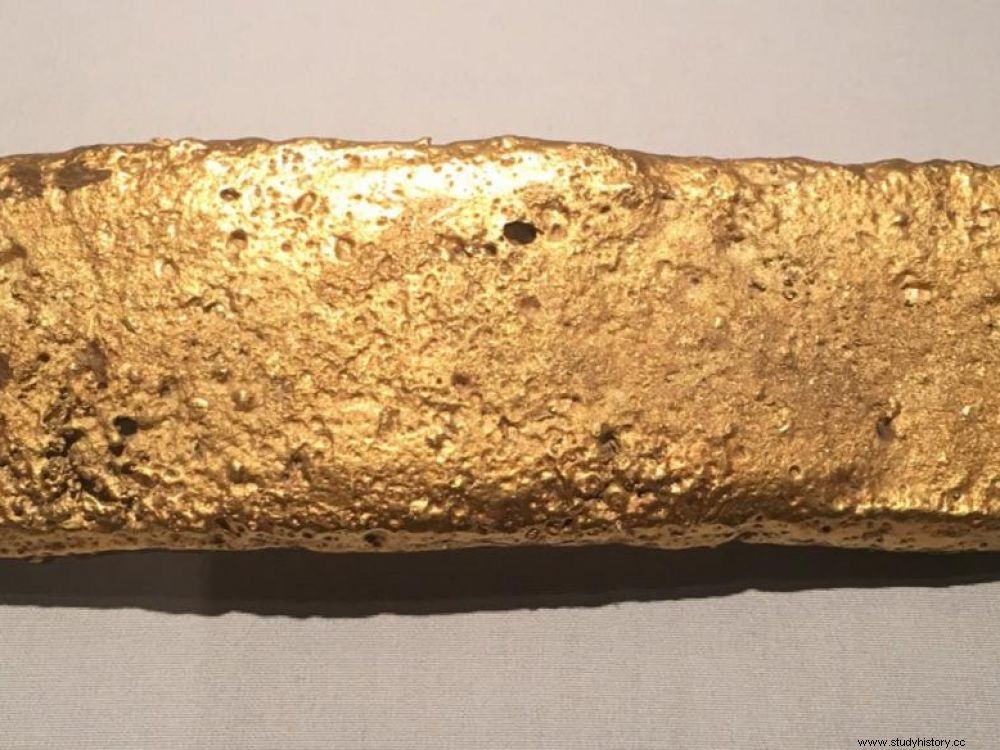
The Noche Triste gold bar kept at the National Museum of Anthropology in Mexico City (Mexico).
That night is known as "Noche triste", the Sad Night... After looting the city of Mexico-Tenochtitlan, the capital of the Aztecs, the armies of the conquistador Hernan Cortés – made up of Spanish soldiers and their native allies – are forced to flee on the night of June 30 on July 1, 1520 in the face of the sudden revolt of the inhabitants. The routed soldiers try, in the dark, to take with them all the gold accumulated for months… A precious metal that they had taken the time to transform into gold bars. Indeed, since their arrival in Tenochtitlan in 1519, the Spaniards had had every opportunity to melt down the numerous treasures stolen from the Indians, this gold sought after with so much avidity in this New World barely discovered 27 years earlier... In Tenochtitlan, the Spaniards had ordered the removal of all the precious metals that covered the Aztec idols, weapons, coins and ornaments of all kinds, sending everything else directly to the stake (featherwork, precious wood, textiles, etc.).
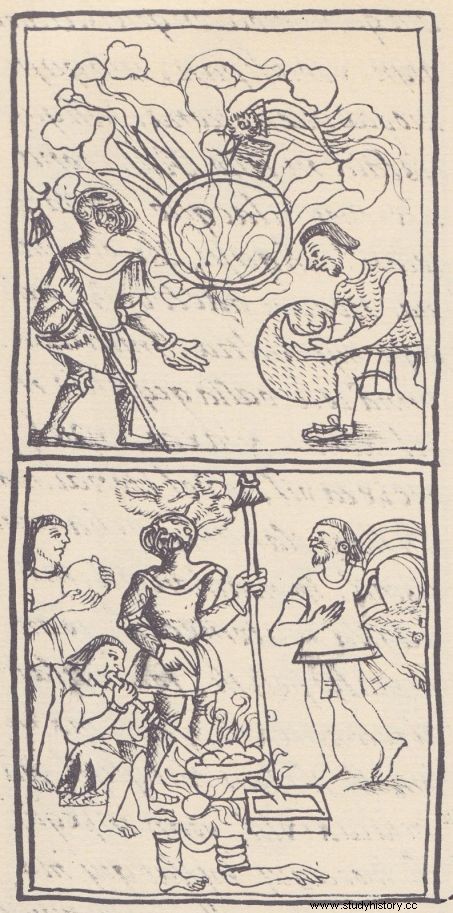
Mexican goldsmiths of Azcapotzalco extracting gold from Aztec idols to smelt them and produce ingots for the Spaniards "who like hungry pigs thirsted for gold", according to the Codex Florentina. © Inah
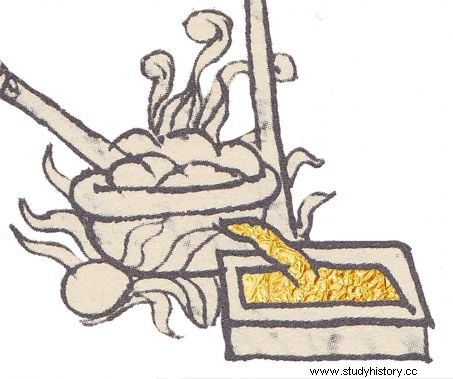
Close up on gold smelting and bullion making. © Inah
Chroniclers of the time say that in their flight, the Spanish survivors dumped part of their booty in the lagoon of Mexico City and that several bars of gold had fallen to the bottom of Lake Texcoco, the immense plan of water that surrounded the prestigious city.
That night is known as "Noche triste", the Sad Night... After looting the city of Mexico-Tenochtitlan, the capital of the Aztecs, the armies of the conquistador Hernan Cortés – made up of Spanish soldiers and their native allies – are forced to flee on the night of June 30 at 1 st July 1520 before the sudden revolt of the inhabitants. The routed soldiers try, in the dark, to take with them all the gold accumulated for months… A precious metal that they had taken the time to transform into gold bars. Indeed, since their arrival in Tenochtitlan in 1519, the Spaniards had had every opportunity to melt down the numerous treasures stolen from the Indians, this gold sought after with so much avidity in this New World barely discovered 27 years earlier... In Tenochtitlan, the Spaniards had ordered the removal of all the precious metals that covered the Aztec idols, weapons, coins and ornaments of all kinds, sending everything else directly to the stake (featherwork, precious wood, textiles, etc.).

Mexican goldsmiths of Azcapotzalco extracting gold from Aztec idols to smelt them and produce ingots for the Spaniards "who like hungry pigs thirsted for gold", according to the Codex Florentina. © Inah

Close up on gold smelting and bullion making. © Inah
Chroniclers of the time say that in their flight, the Spanish survivors dumped part of their booty in the lagoon of Mexico City and that several bars of gold had fallen to the bottom of Lake Texcoco, the immense plan of water that surrounded the prestigious city.
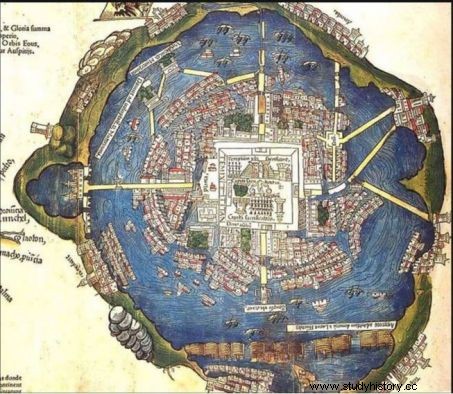
Historical plan of Mexico-Tenochtitlan published in 1524 by Friedrich Peypus (1485–1534), probably from a drawing made by a man by Hernan Cortés. © Inah
"This is a huge discovery in the history of the Conquest"
If subsequently, as the texts indicate, Spaniards returned to the scene to recover as many of these precious objects as possible, never the slightest material clue to this tragic episode had until then been brought to light! Now this has just been done, thanks to the chemical analysis of an ingot weighing nearly 1.930 kg carried out nearly 40 years after its discovery in March 1981 during work carried out in a street in Mexico City. Joined by Sciences et Avenir , Leonardo Lopez Lujan, archaeologist of the National Institute of Anthropology and History of Mexico (Inah), co-signatory of the article which has just been published in the journalArqueologia mexicana , does not hide his enthusiasm, the analyzes showing without possible error that this gold is indeed from Tenochtitlan. "It is an immense discovery in the history of the Conquest, this ingot is the only material survivor of the tragic event of the Noche Triste.." . The operation took place within the framework of the Templo Mayor project led by the specialist :"We have undertaken to analyze the collection of gold objects discovered in the offerings of the sacred site of Tenochtitlan , he continues. One of our main objectives was to estimate, for each of them, their true gold, silver and copper (Au-Ag-Cu) content in order to compare them with those from other sites, like the precious objects unearthed in the Templo Mayor or in the sacred cenote of Chichen Itza" .
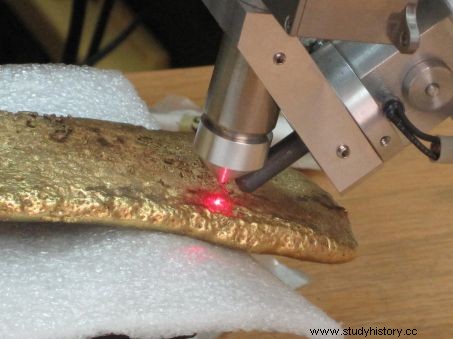
Analysis of gold bullion by X-ray fluorescence spectrometry (XRF). © Jose Luis Ruvalcaba Sil
A non-invasive analysis
To do this, the Mexican archaeologists therefore carried out X-ray fluorescence spectrometry (XRF) analyses, a non-invasive and non-destructive chemical analysis technique that makes it possible to identify the composition and precise concentrations of the elements in a sample. . It thus enabled them to observe that the gold of Tenochtitlan differed from that of other Mesoamerican zones by its lowest percentages of copper. "Of 23 XRF measurements performed on different parts of this gold bar, we found that this piece was very homogeneous in its composition with an average of 76.22 ± 1.03% gold, 20.75 ± 0.98% silver and 3.03 ± 0.53% copper, all melted at 950°C" , specifies Leonardo Lopez Lujan. Scholars conclude that the coins smelted to form the ingot were either from the hoard known as the "Treasure of the Ancestors of Moctezuma", found by the Spaniards in Teucalco , the place where Aztec treasures were kept; either from gold salvaged as spoils of war from the Royal Stores of Petlacalco, the Armories of Tlacochcalco, or the Totocalli Workshops of Tenochtitlan. Moreover, still according to the Mexican expert, in the 16th century, in his "True History of New Spain", Bernard Díaz del Castillo (1492-1584) explained that the metal resulting from the looting "began to melt with the Indian goldsmiths from Escapuzalco, who made it into very wide three-finger bars ". Important data for scientists. Indeed, the measurement of a finger is equivalent to 1.8 cm, "the 5.4 cm of three fingers" coincide perfectly with the dimensions of the ingot "5.4 cm wide" , 26.2 cm long and 1.4 cm thick found in 1981.
In a press release, the National Institute of Anthropology and History of Mexico (Inah) specified that the discovery of the ingot in 1981 had been made in the northwestern part of the city where there were the remains of many prehispanic dwellings. Leonardo Lopez Lujan still remembers the precise memory of this discovery:"It was very early, the morning of March 13, 1981, when a mechanical shovel extracted from the silt of the bed of a secondary channel - identified as the old ditch of Toltecaacaloco - a yellow metallic bar which had a quadrangular shape and a marked curvature. It was at a depth of 4.80m." The place of discovery is a few meters from the Tlacopan causeway, the route that Hernán Cortés and his men - laden with gold - had tried to take in the debacle.
Today, to admire this unique testimony of the "Noche Triste" , you have to go to the National Museum of Anthropology in Mexico City, where it is exhibited.
La Noche Triste and its aftermath
The Historical Chronicles tell that the day after the "Noche Triste", on the night of June 30 to the 1
st
July 1520, which saw the Spanish soldiers flee before the revolt of the Indians, the Aztecs of Tenochtitlan returned to the "canals of Toltecaacaloco, Petlacalco and Mictlantonco" to try to recover the booty taken by the conquistadors. About 600 corpses of Spaniards and 800 of their Tlaxcaltec and Cempoaltec allies were then taken out of the waters of the lake while locals scavenged "spears, swords, halberds, crossbows, shotguns and artillery pieces" …
But a year later, the conquistador Hernan Cortés, having reconstituted a new army, returned to lay siege to Mexico-Tenochtitlan to avenge the affront of this tragic night and avenge his people. His victory, August 13, 1521, will be the date chosen to mark the end of the Aztec Empire. Captured by Cortes, Cuauhtémoc, the last "emperor" (tlatoani "one who speaks" ) was to be executed in 1525, after four years of imprisonment.
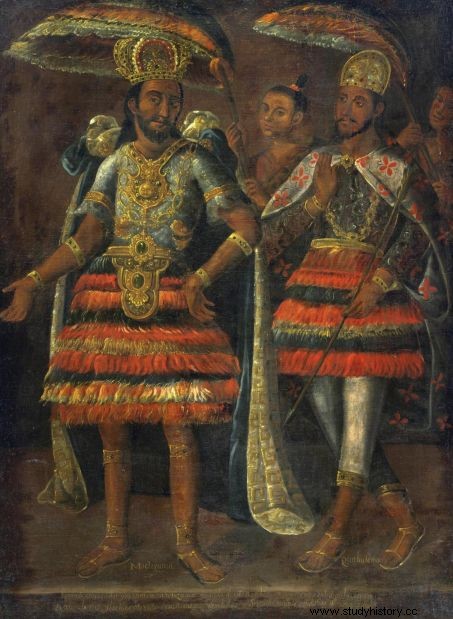
The Aztec emperors Cuauhtémoc (1495-1525) and Moctezuma (1466-1520), both victims of the Spaniards. Credits:Leemage/AFP
Gold of the Americas
Devoid of any market value, gold, a symbol of power, was the object of true devotion among the Indians of pre-Columbian societies. By adorning yourself with this sacred metal, or by clothing their idols, the elites could identify with the almighty demiurges. In pre-Columbian societies and for three thousand years, gold aroused devotion and respect. Stainless, unalterable, it was associated with eternity and immortality…but not worth merchant, to the amazement of the conquistadors, eager to seize it. The gold ornaments worn by the political and religious elites legitimized a power of divine essence among the populations.
To find out more, read "The Lost Gold of the Americas" , by Bernadette Arnaud, Sciences et Avenir n°779, January 2012
